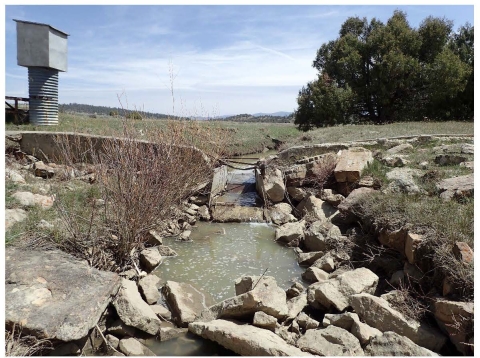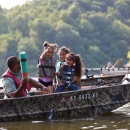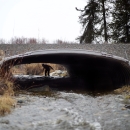States
New MexicoThis project will remove two fish passage fish passage
Fish passage is the ability of fish or other aquatic species to move freely throughout their life to find food, reproduce, and complete their natural migration cycles. Millions of barriers to fish passage across the country are fragmenting habitat and leading to species declines. The U.S. Fish and Wildlife Service's National Fish Passage Program is working to reconnect watersheds to benefit both wildlife and people.
Learn more about fish passage barriers on Willow Creek in the Rio Chama watershed that negatively impact three native fish species - the Rio Grande chub (under Endangered Species Act status review), the Rio Grande sucker (under Endangered Species Act status review), and the flathead chub. The project barriers consist of an abandoned stream measurement flume and a perched culvert associated with a dirt road crossing. Removing the flume, naturalizing the channel, and replacing the perched culvert with a bottomless culvert at these sites will allow fish movement at critical times in these species' life histories. Removal of these barriers will reconnect approximately 11.3 miles of currently inaccessible habitat, reduce flood risk, increase Tribal member access to prominent hunting areas, and improve public safety.
Project Quick Facts:
| Location | New Mexico |
| NFPP Project Funding | $350,000 |
| Restoration Techniques | Culvert Replacement |
| Partner Project Lead | Jicarilla Apache Nation Game & Fish Dept. |
The National Fish Passage Program combines technical expertise with a track record of success.
Implemented primarily through the Service's Fish and Wildlife Conservation Offices, the National Fish Passage Program provides financial and technical assistance to partners across the country. Since 1999, the program has worked with over 2,000 local communities, Tribes, and private landowners to remove or bypass over 3,400 barriers to fish passage and reopen access to over 61,000 miles of upstream habitat for fish and other animals. Staff have expertise in fish migration and biology as well as financial, engineering, and planning assistance to communities, Tribes, and landowners to help them remove barriers and restore rivers for the benefit both fish and people.
Fish passage project proposals can be initiated by any individual, organization, government, or agency. However, proposals must be submitted and completed in cooperation with a Fish and Wildlife Conservation Office. (Please note that fish passage projects being used for federal or state compensatory mitigation or required by existing federal or state regulatory programs are not eligible for funding through the National Fish Passage Program.)
CONTACT A FISH PASSAGE COORDINATOR IN YOUR AREA TO GET STARTED.



